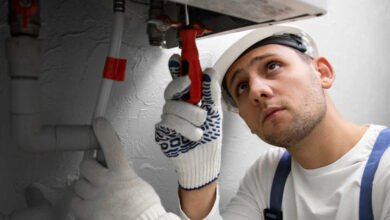Don’t Let Your Sump Pump Fail You: Signs It’s Time for a Replacement

Having a sump pump in your home is essential for keeping your basement and crawl spaces dry. But over time, sump pumps can start to fail, leading to water damage and other costly problems. Knowing when it’s time to replace your sump pump is key to preventing these issues. In this blog post, we’ll look at some common signs that you may need to replace your sump pump. Armed with this knowledge, you can take the necessary steps to ensure your home remains dry and safe.
Why You Need to Replace Your Sump Pump
Having a sump pump in your home is not just a luxury – it’s a necessity. But why exactly do you need to replace your sump pump? Well, there are a few reasons.
First and foremost, sump pumps have a limited lifespan. Typically, they last between 10 and 15 years, depending on the quality of the pump and how well it’s been maintained. As the pump ages, its efficiency decreases, making it less effective at removing water from your basement or crawl spaces. This can lead to an increased risk of flooding and water damage, which can be expensive to repair.
Another reason to replace your sump pump is to take advantage of advancements in technology. Newer models often come with improved features and capabilities, such as backup power options and remote monitoring. These enhancements can provide added peace of mind and protection for your home.
Lastly, replacing your sump pump before it fails completely allows you to plan and budget for the expense. Waiting until your sump pump fails can result in a rushed and costly replacement, especially if you’re dealing with a flooded basement at the same time.
Understanding the Lifespan of Your Sump Pump
When it comes to your sump pump, understanding its lifespan is crucial. Knowing how long you can expect it to last can help you plan for a replacement before it fails completely. On average, sump pumps have a lifespan of around 10 to 15 years, but this can vary depending on various factors.
The quality of the pump itself plays a significant role in its longevity. Investing in a high-quality sump pump from the beginning can extend its lifespan. Regular maintenance and upkeep are also essential. Over time, debris and sediment can build up in the pump, affecting its efficiency. Regular cleaning and inspection can help prevent clogs and keep your sump pump running smoothly for longer.
Additionally, the amount of usage your sump pump gets can impact its lifespan. If you live in an area with heavy rainfall or a high water table, your sump pump may be working harder and more frequently, which can shorten its lifespan.
Understanding the lifespan of your sump pump is vital for proactive maintenance and replacement. By keeping an eye on the age, quality, and usage of your pump, you can ensure the continued protection of your home against water damage.
Signs That Your Sump Pump is Failing
If you have a sump pump in your home, it’s crucial to be able to recognize the signs that it’s failing. Ignoring these signs can lead to a flooded basement or crawl space, resulting in costly water damage and potential health hazards. So, how can you tell if your sump pump is on its last legs?
One clear sign is unusual sounds coming from the pump. If you notice grinding, rattling, or screeching noises, it’s a red flag that something is amiss. These noises can indicate that the pump’s motor or impeller is worn out and in need of replacement.
Another sign to watch for is increased cycling. If your sump pump is turning on and off more frequently than usual, it could mean that it’s struggling to keep up with the amount of water entering your basement. This could be due to a clog or a failing switch.
Additionally, pay attention to the presence of excess moisture or dampness in your basement or crawl space. If you notice musty odors or feel dampness on the walls or floors, it’s a sign that your sump pump may not be effectively removing water.
Lastly, if your sump pump is older than 10-15 years, it’s time to seriously consider replacing it. Even if it seems to be functioning properly, the risk of failure increases as it ages. It’s better to be proactive and replace it before you have a basement full of water.
By keeping an eye out for these signs, you can stay ahead of potential sump pump failures and protect your home from water damage.
The Consequences of Waiting Too Long to Replace Your Sump Pump
Neglecting to replace your sump pump in a timely manner can have serious consequences for your home. The most obvious consequence is the risk of a flooded basement or crawl space. When a sump pump fails, water can quickly accumulate, causing extensive damage to your belongings and the structure of your home. The costs associated with water damage can quickly add up, including repairs to walls, floors, and electrical systems. Not to mention the potential for mold growth, which can be a health hazard.
Waiting too long to replace your sump pump can also put a strain on your finances. When you’re dealing with a flooded basement, you don’t have the luxury of shopping around for the best deal on a replacement pump. You’re more likely to make a rushed decision and end up paying more than necessary. On the other hand, if you plan ahead and replace your sump pump before it fails, you can take the time to research and find the best pump for your needs at the best price.
Don’t forget about the peace of mind that comes with a functioning sump pump. Knowing that your basement and crawl spaces are protected from water damage can help you sleep better at night and enjoy your home without worrying about costly repairs. So, don’t wait until it’s too late. Stay ahead of potential sump pump failures and protect your home by replacing your sump pump at the right time. It’s an investment that’s well worth it in the long run.
Tips for Choosing a New Sump Pump
Choosing a new sump pump may seem like a daunting task, but with the right tips and guidance, you can make an informed decision. Here are some tips to help you choose the best sump pump for your needs.
First, consider the size and capacity of the sump pump. It’s important to choose a pump that is capable of handling the amount of water that enters your basement or crawl space. Measure the depth and width of your sump pit to determine the appropriate size. Additionally, consider the horsepower and pumping capacity of the pump. A higher horsepower pump with a greater pumping capacity is suitable for larger areas or areas with high water tables.
Next, think about the type of sump pump you need. There are two main types: submersible and pedestal. Submersible pumps are placed inside the sump pit and are generally quieter and more discreet. Pedestal pumps, on the other hand, are positioned above the pit and are easier to access for maintenance and repairs.
Don’t forget to check for additional features. Look for a pump with a backup power option, such as a battery or generator, to ensure it continues to work during power outages. Consider a pump with a built-in alarm system that alerts you when the water level rises. Remote monitoring capabilities are also helpful for keeping an eye on your sump pump’s performance.
Lastly, do your research and read reviews. Look for reputable brands and models with positive customer feedback. Take note of any warranty or guarantee offered by the manufacturer, as this can give you peace of mind knowing that you’re investing in a quality product.
By following these tips, you can confidently choose a new sump pump that meets your specific needs and provides reliable protection for your home.
Proper Maintenance to Extend the Life of Your New Sump Pump
Proper maintenance is essential for extending the lifespan of your new sump pump and ensuring it continues to work effectively. Here are some tips to help you keep your sump pump in top shape:
- Regular Cleaning: Remove any debris or sediment that may accumulate in the sump pit. This will prevent clogs and keep the pump running smoothly. You can use a wet-dry vacuum or a small brush to clean the pit.
- Test the Pump: Regularly test your sump pump by pouring water into the pit and ensuring that it activates and pumps out the water properly. This will help you identify any issues early on.
- Check the Discharge Pipe: Inspect the discharge pipe to make sure it’s clear and free from obstructions. This will ensure that water is properly directed away from your home’s foundation.
- Inspect the Float Switch: The float switch is responsible for activating the pump when the water level rises. Make sure it’s moving freely and not getting stuck. If it’s not working properly, consider replacing it.
- Backup Power Options: If your sump pump doesn’t already have a backup power option, consider adding one. This will ensure that your pump continues to work during power outages.
By following these maintenance tips, you can significantly extend the life of your sump pump and reduce the risk of unexpected failures. Remember, regular upkeep is key to keeping your basement and crawl spaces dry and protected. If you need a new sump pump in Indianapolis, check out Coopers Water.




